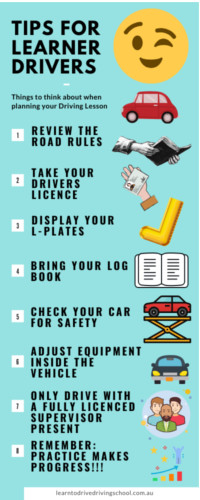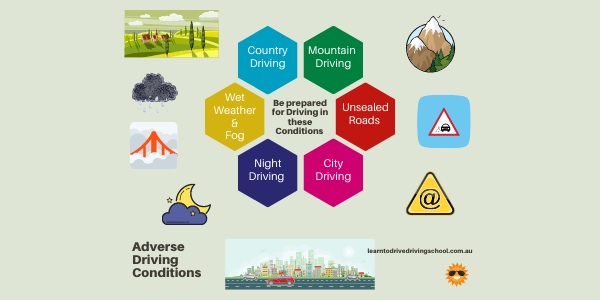Tips for Learner Drivers
Learning to drive is a process that everyone goes through. No one just gets in a car and knows how to drive you need to learn how to drive. In NSW you have to tick a lot of boxes to get a provisional driving licence and it will take you more than a year. As a driving instructor I have prepared a list of tips for learner drivers to help guide you through the process.
The first tip is do not rush learning to drive. It takes time to learn to drive that is why the government has made it compulsory for learner drivers to complete 120 hours of driving. Don’t get frustrated if there is something you can not do straight away. Everyone struggles with at least one aspect of driving. Keep practising and with time you will get better at it. You will not be able to do the driving test for a provisional drivers licence until you have completed 100 hours of day time driving and 20 night hours. So you have plenty of time to practice and perfect the various skills of driving.
Tips for learner drivers before you get in the car
- Review the road rules. When you are driving you will need to make decisions in fractions of a second. You will not have a lot of time to think about your answer.
- Have a secure location to keep your drivers licence with you. You may be pulled over by the police and you must have your licence with you.
- Check the car you are going to drive in to make sure it is safe to drive. Make sure you check the brake lights, blinkers and tyres. It is illegal and dangerous to drive if the car is not roadworthy.
- Make sure your L Plates are clearly displayed at the front and rear of the vehicle.
- Make sure you have your learner log book with you and it is stored in a safe place whilst you are driving.
- Have a supervising driver with you who has a full drivers licence.
- Check you brake and blinker lights are working properly
- Make sure the tyres have good tread and are properly inflated
Things to do before you drive
- Get comfortable behind the wheel. Adjust the seat and head rest, make sure you are comfortable and that you can see properly. The head rest should be adjusted so that the top of the head rest is at least at eye level. You do not want to suffer a neck injury because you did not adjust the seat.
- Adjust the steering wheel so you have a good view of the road ahead as well as the instrument panel.
- Familiarise yourself with the instrument panel. Make sure you can clearly see the instrument panel. When a warning light comes on you want to see it and know what it means and what you should do.
- Adjust the mirrors and make sure you can see properly. You do not want to cause an accident because you could not see properly.
- Check you can operate the important car properly including blinkers, wipers, demisters, horn and hand brake.
Tips for Learner Drivers – Plan your driving lesson
You will learn more and become a better driver if you have a plan to ensure you cover all aspects of driving. Driving to and from school to complete 120 hours in your log book is not a good plan. Driving over the same roads and repeating the same thing will only help until you have mastered it. Continuing to repeat the same things you already know will not help you become a better driver.
- Know what you need to practice and improve on. Use your driving time to become a better driver. Don’t just rack up the hours, learn from the experience
- Learn something new and work your way through the learning goals at the front of your log book. The Roads & Maritime Services have given you a list of things you need to know for the driving test. Spend your time preparing for the test.
- Make sure each time you drive you build on what you already know and learn something new.
- Start out in quiet back street and develop the necessary skills for steering, road position, scanning and decision making. Then move into light traffic and get used more road users around you. Then when you are comfortable move into more traffic. Do not drive in conditions you are not ready for. Build up your skills and get ready for the conditions you are going to drive in.
- As your road skills improve add in more complex traffic and practice driving under adverse conditions.
- Get regular practice preferably at least once a week
- Practice on different roads unmarked roads, marked roads, multiple lane roads, quiet street and busy streets.
- Practice driving in different conditions including, peak hour traffic, rain, fog, sunrise, sunset, driving whilst distracted. Check out our web page offer for a FREE Keys2Drive lesson.
When you have learnt how to drive safely and developed a good driving technique then you are ready to progress to more difficult and adverse driving conditions.

Practice Driving Under Adverse Conditions
The more practice you get the better you will become. Doing something once or twice does not make you an expert. Some things like driving take a lot longer to become good at. Make sure you get lots of practice on different roads and under different conditions. It is better if you learn to drive under every road condition with your supervising driver who can help and guide you. Some road conditions to practice on are
- Mountain driving. If you are thinking of doing your driving test in the Mountains we have been teaching students to drive in the Blue Mountains for many years. Our local driving instructors in Springwood NSW provide high quality driving lessons in a relaxed and stress free environment.
- Driving at Night: Remember in NSW you have to complete 20 log book hours of Night Time driving before you can do the driving test.
- Wet weather driving: It is harder to drive in the rain. Never knock back the chance to practice driving in the wet with a driving instructor
- City Driving: Is very different to driving in the suburbs or rural areas. If you do not get the opportunity to drive in city traffic take a city driving lesson. It will improve your decision making and help you become a better driver. In addition you will be better prepared for your driving test.
- Country Driving:
- Driving on unsealed (dirt) roads
-

When you have developed a good driving technique and learnt how to drive safely in adverse driving conditions you are nearly ready for your driving test. The last thing you should do is learn how the examiners mark the driving test and find out what is actually involved in the d
riving test. The best way to do this is with a practice driving test with your local Learn to Drive driving instructor.
Because each Learn to Drive Driving Instructor works extensively with the local Roads & Maritime Services they know what is in the test. Therefore they will be able to explain everything to you and get you ready to pass the driving test First Go!

